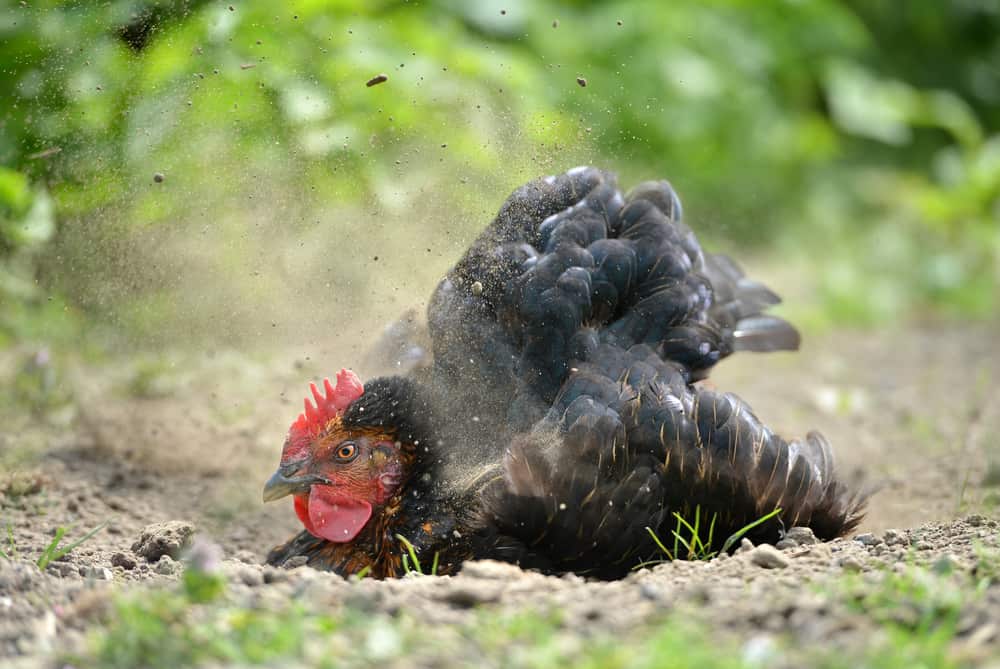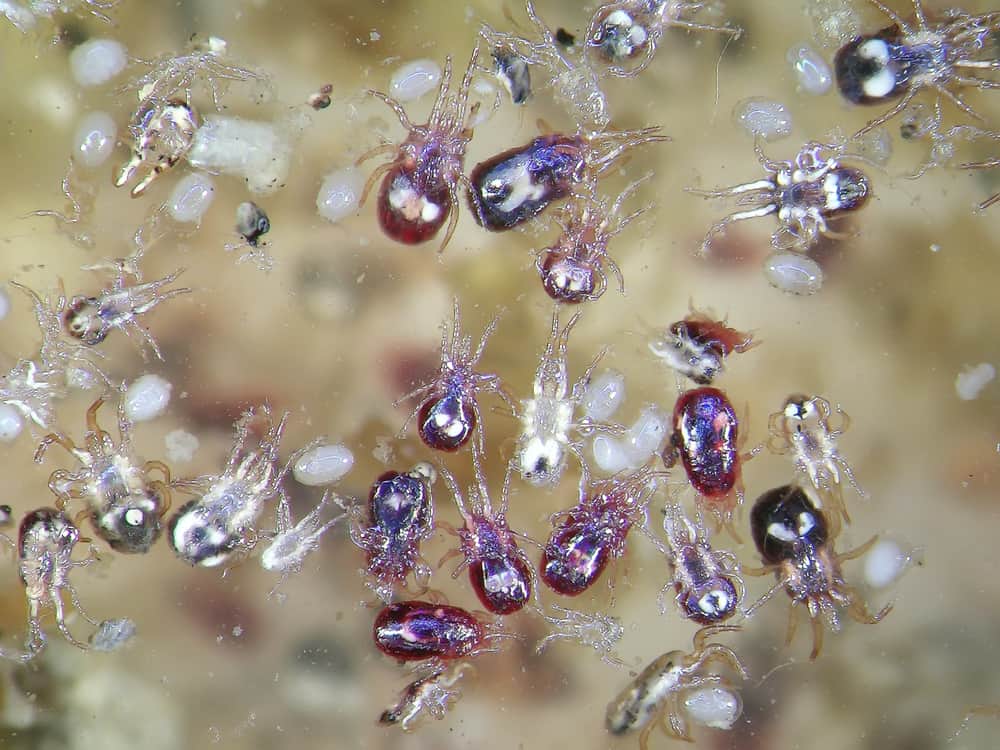
Chickens are an simple way to begin homesteading whether you’re a beginner or want to experience a bit of the country atmosphere. Even though chickens may need assistance at times, They are prey to predators, diseases, and parasites, just like other species.
Foxes are well-known for sneaking into henhouses, but Chickens’ diseases and parasites are lesser-known. Chickens in general manage to stay healthy with very little assistance from you. This also means that if you realize something is wrong with your hens, you have a difficult time deciding what to do.
Mites, on the other hand, are relatively easy to remove. Just a little understanding, a few equipment, and a lot of willpower will suffice.

What Are Chicken Mites?
Mites are tiny parasitic insects that feed on your birds. They may be seen a lot during warm and damp weather, but they can also survive in colder temperatures (albeit it is less typical).
One of the most bizarre parasites I’ve encountered is chicken mites. When your henhouse is overrun with itchy, miserable birds and destructive mites, they’re so tiny that it’s difficult to notice them.
Ticks and chicken mites are closely linked. They resemble small ticks in appearance as well. Arachnids have eight legs and a overweight little body.
They feed on the blood of your chickens, like little vampires, and feed on the bodies of birds. Mites, unlike vampires, have a short life cycle. Within a week, they are born, grow up, and die. Mites feed on your chickens from the time they are born. That makes your birds peck and scratch at each other because of their itchy, painful condition.

Northern fowl mites (Ornithonyssus sylviarum) and Dermanyssus gallinae, or red mites, are the two most common chicken mites. In the United States, northern fowl mites are the most common kind of bird mite. In the United States, the red mite is less common, although it is more common in the United Kingdom and Europe. When hungry, both mites are black or gray, but when full of chicken blood, they turn red.
Mites are spread by contact and may survive for three weeks on their host.
If left unchecked, both may decimate a flock. They’re bothersome to your birds in small numbers, but a large infestation can deplete their health and even kill them.
How to Identify an Infestation
It’s difficult to identify a mite infestation early on because they’re so tiny and are mostly active at night. However, your mites can be tracked down in a variety of ways. Start by inspecting your birds if you suspect your coop is being invaded.
Chicken Inspection

Grab a hen and take her home with you. Hold her ankles with her head downward until she calms down. She’ll spread her wings out and relax. You might check for clumps of tiny parasites on her skin by looking under the wings and parting the feathers around her vent.
Take a look at her skin while you’re at it. Is it scaly, crimson, or swollen? Are there blood stains on her limbs? Mites are responsible for all of these symptoms.
You know there’s an infestation if you see any sign of mite damage on your hen. Mites reproduce quickly and have a short life span. One bird’s mite damage indicates that your whole flock is likely affected. It’s time to take action.
Coop Inspection
Check your coop if the chicken inspection was inconclusive, or you want to know how much damage there was. nighttime is the best time to accomplish this. Bring a flashlight and a sheet of paper. Chickens are sleepy at night, which makes them simple to handle. While roosting, they are also susceptible to mites.
At night, nocturnal mites emerge to feed. You may be able to observe the mites on your perches if you have a severe infestation. Otherwise, examine the white paper under a flashlight after rubbing it along the perch. Mites are feeding in your coop if there are red smears on the paper.
Fighting Back
It’s time to get to work if you know your coop is infected. Getting rid of mites is difficult. The greatest reaction, according to most chicken owners, is to destroy everything and start over. We then sigh and pick up the diatomaceous earth to begin treating our birds.
Dusted with diatomaceous earth, your birds will be flock-friends from the start. DE is beneficial to your birds because it splits the mites up on their bodies. It’s akin to the sensation of gently washing dry, itchy winter skin with a nice soap. Mix a cup of diatomaceous earth into a sandbox of dirt and sand for your birds to rub in if your run is dry.
Give your fowl the chance to dustbathe on a regular basis since this is their natural way of fighting mites.
Also, mites may make your chicken anemic, so be sure to check this out. Feeding them greens, meat, and eggs will help to boost their immune system. Their iron levels will be increased as a result of this.
Internal Remedies
Give your hens a little extra water from the cider vinegar. While you’re battling the mites, apple cider vinegar isn’t much help in drying them up or improving their nutrition.
Garlic, mint, rosemary, and onions are among the strong-smelling herbs and spices you can feed your chickens. These will help your birds seem less appealing to the mites, rather than make them taste better.
Coop Care
Northern fowl mites spend the majority of their lives on their host birds. Red mites prefer to hide inside the coop when they aren’t eating. Despite the differences, it’s important to clean up when you’re dealing with either mite. Remove the cage’s bedding and put it out of reach. The most effective way to get rid of mites is to burn the mattress, but if you’re in a hurry or live in a dry environment, simply wrapping it up and tossing it away might be an option.
It’s essential to notify the mites that they are not welcome back once the coop is clean of birds and bedding. Spray with neem oil or dust with diatomaceous earth.
Neem Oil
This mild and very successful oil kills mites, lice, ticks, and fleas by interrupting their lifecycle. It is made from the seeds of the neem tree. You can also apply neem oil to your chickens directly, since it nourishes the skin.
In a spray bottle of apple cider vinegar and water, mix 2 teaspoons of neem oil. Spray the coop’s walls and nesting boxes, especially in the corners. Afterwards, leave the coop open for at least three days, preferably a week. While cleaning the coop, keep your chickens somewhere else. In good weather, I keep my birds in antique dog crates or let them have an open area.
You may directly apply a neem-water solution to your hens. I like to give my fowls a neem bath
instead. Drench your birds in a gallon of warm water containing a few teaspoons of neem.
Chemical Options
Natural remedies may not always be effective. I live in the frozen north, where mites (who prefer warm spring and summer temperatures) tend to die off for 5 months out of the year, so I’ve never had an infestation so bad that my natural choices can’t fight it off.
You may need a stronger solution in more temperate areas, where mother nature never helps you fight off the mites. Unfortunately, many chemical mite pesticides are harmful to other species as well. Permethrin is the most secure option.
Permethrin is offered in both liquid and powdered forms. You can use it to apply straight to your hens’ feathers, which is a coop spray. Permethrin is very dangerous to cats, so keep your pets away from the coop and clean thoroughly during treatment and for a few days after treatment.
Scaly Leg Mites
Scaly leg mites might be the cause of your birds’ feet having a thick skin on top.
Scaly leg mites (Knemidocoptes mutans) can live through the winter, and although they don’t resemble other kinds of mites, they may still bother your flock. By examining your hens’ feet, you’ll know you have them. The scales on their legs and feet stick up as a result of these mites burrowing beneath their skin. These nasty parasites bite and suck blood from your chickens, which makes it painful for them.
Of course, if you see this, you’ll want to do something about it right away.
How to Beat Them
So it turns out that a parasite has taken up residence on your birds’ feet, giving them gross-looking pads.
You can start by following Fresh Eggs Daily’s recipe. Parasites don’t like the taste of garlic juice. It exterminates them and discourages others from setting up residence on your property. You’ll then apply Vaseline to their legs.

Next, you’ll dip their feet or rub their feet down with oil. Oil smothers mites.
Prevention
You never want to do it again once you’ve been mite-free. Mites may be kept at bay with a little care. To help prevent mites, put a few dried herbs in your chicken coop. Herbs like chamomile, mint, garlic, and thyme, according to studies, may make the coop unattractive to chicken mites and help your flock live longer.
DE should be sprinkled in the coop on a regular basis. In order to avoid infestations, I make it part of my weekly cleaning routine. Sprinkle a little Diatomaceous earth in the coop when you’re mucking out the coop and spray a little neem oil.
Make sure your hens have a chance to roll in the dirt as well. If you give them the opportunity, they may stay relatively mite-free. Chickens may find it difficult to detect dusty ground if the weather is wet and humid. To assist your birds resist mites throughout the humid months, administer a neem spray treatment.
Can Mites Move from Chickens to People?
They don’t usually bite humans, but they can do so. Human infestations by chicken mites have, however, been documented.
A wide range of birds are commonly infested with chicken mites. Ducks, geese, guineas, and turkeys are all at risk if you keep them. Mites, on the other hand, can’t survive off of you since they’ll happily bite you. Itchiness, discomfort, inflammation, and irritation may all be symptoms of mite bites.
Your dogs and cats are generally safe as well.